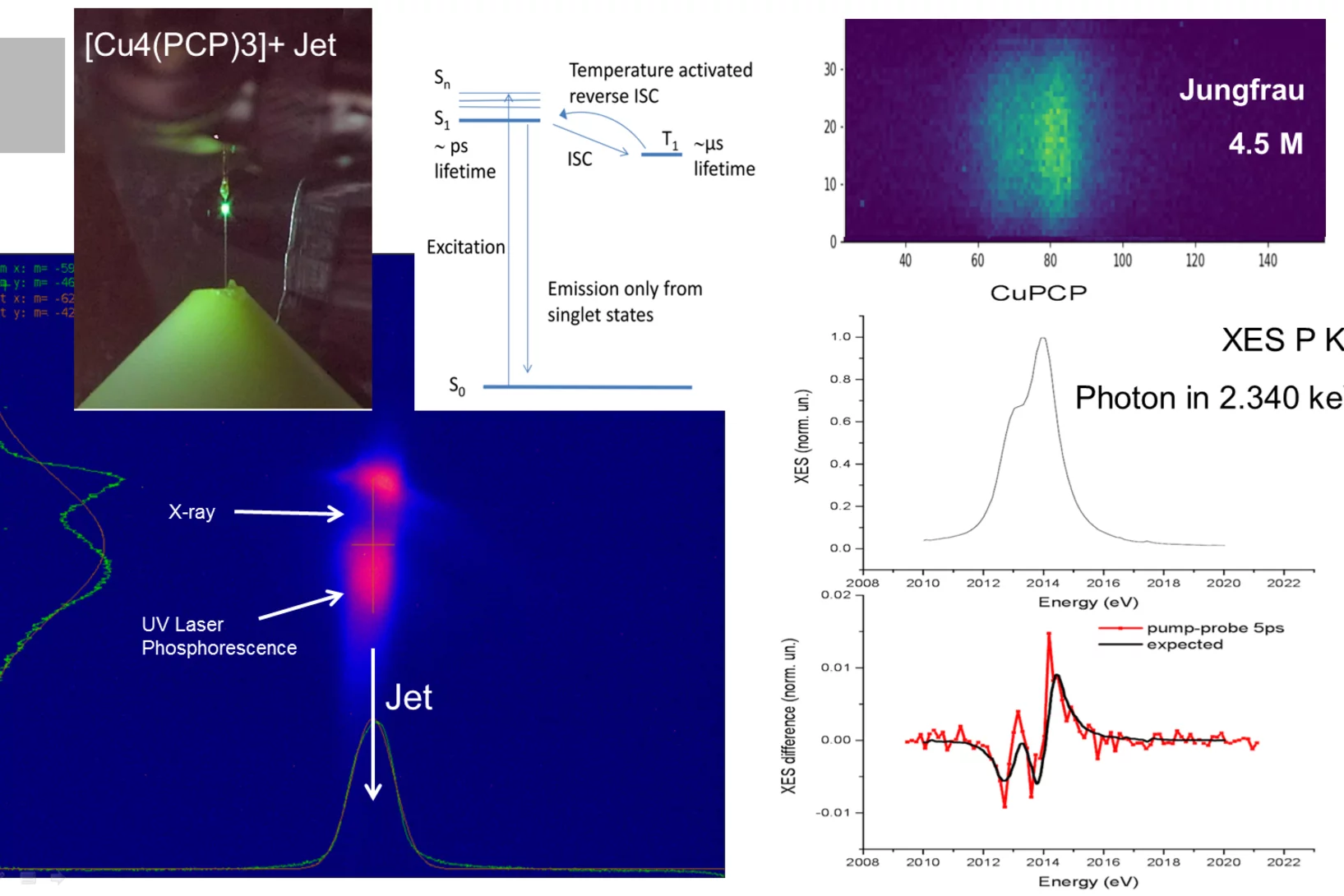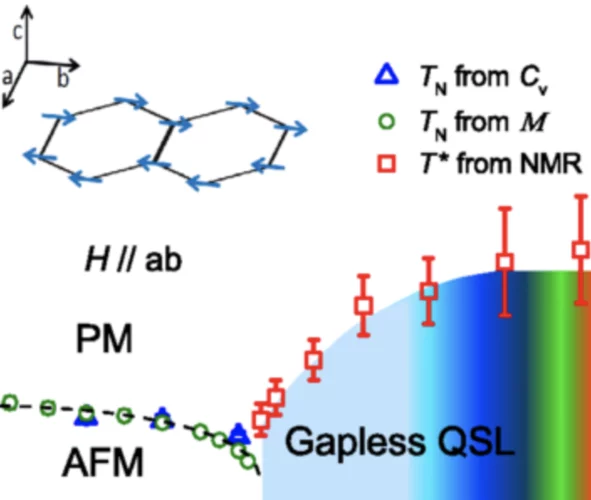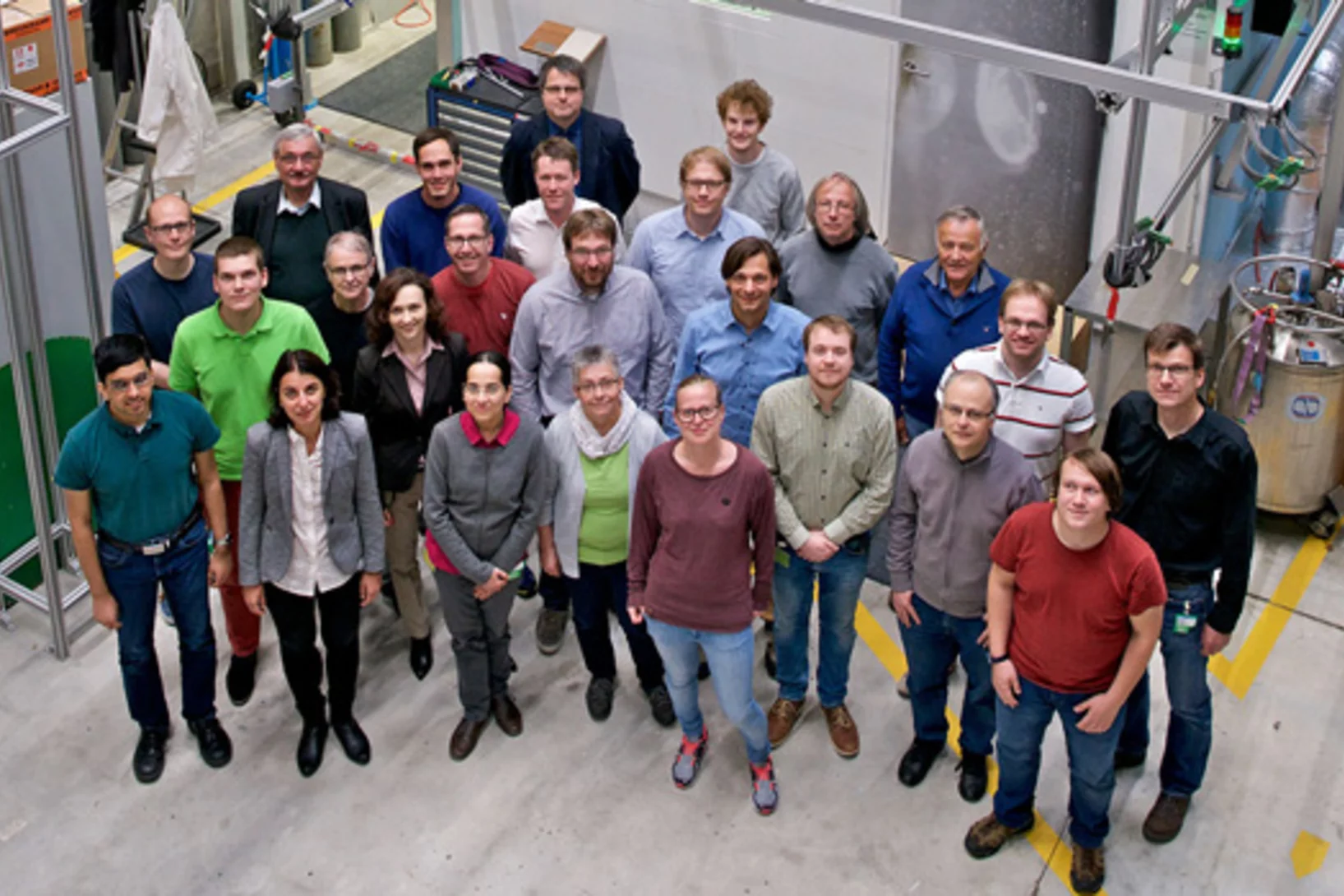Au PSI, plusieurs projets se consacrent à des questions de recherche importantes autour du coronavirus Sars-CoV-2 et des maladies qui en résultent. Nous vous informons sur les activités et les projets, par exemple sur les analyses de tissus pulmonaires, sur la production de protéines et d'anticorps ou sur les idées de nouvelles recherches sur le Covid-19.
Liens utils
Des nanoaimants pour produire du courant électrique
Oles Sendetskyi, lauréat d'un Founder Fellowship à l'Institut Paul Scherrer PSI, veut utiliser l’inversion de polarité de certains nanoaimants pour développer une source durable de courant électrique pour petits appareils.
First Pilot Experiment at SwissFEL-Alvra on UV photo-induced charge transfer in OLED system
On the 17th of December 2017 SwissFEL saw its first pilot experiment in the Alvra experimental station of the SwissFEL ARAMIS beamline. A team of scientists from the University of Bremen, Krakow and PSI, led by Matthias Vogt (Univ. Bremen) and Chris Milne (PSI)in collaboration with J. Szlachetko, J. Czapla-Masztafiak, W. M. Kwiatek (Inst. of Nucl.Phys. PAN (Krakow), successfully did the first pilot experiment at SwissFEL-Alvra on UV photo-induced charge transfer in OLED system.
First Pilot Experiment at SwissFEL-Alvra: UV photo-induced charge transfer in OLED system
On the 17th of December 2017 SwissFEL saw its first pilot experiment in the Alvra experimental station of the SwissFEL ARAMIS beamline.
Nous démarrons avec 500 millions de muons
Les muons permettent d’étudier les matériaux de l’électronique du futur. Entretien sur la spécificité de ces particules élémentaires avec Alex Amato et Thomas Prokscha, chercheurs à l'Institut Paul Scherrer PSI.
Macroscopic phase separation of superconductivity and ferromagnetism in Sr0.5Ce0.5FBiS2-xSex revealed by μSR
The compound Sr0.5Ce0.5FBiS2 belongs to the intensively studied family of layered BiS2 superconductors. It attracts special attention because superconductivity at Tsc = 2.8 K was found to coexist with local-moment ferromagnetic order with a Curie temperature TC = 7.5 K. Recently it was reported that upon replacing S by Se TC drops and ferromagnetism becomes of an itinerant nature.
The field-induced quantum spin-liquid phase of α−RuCl3 is gapless
Throughout 2017, the material α−RuCl3 has continued to inspire and fascinate those interested in correlated condensed matter. New experimental data now provide unique insight, and pose fresh challenges.
La première expérience conduite au SwissFEL a été un succès
Les méticuleuses années de planification et de construction ont porté leurs fruits: la première expérience conduite à la nouvelle grande installation de recherche de l’Institut Paul Scherrer PSI, le laser à rayons X à électrons libres SwissFEL, a été un succès. Ce faisant, deux objectifs ont été atteints: d’un côté l’obtention d’un nouveau résultat scientifique, de l’autre une optimisation de l’interaction entre les nombreux composants de cette installation extrêmement complexe.
Jean-Baptiste Mosset winner of PSI Founder Fellowship
Jean-Baptiste Mosset from the Laboratory of Particle Physics is the winner of a PSI Founder Fellowship and plans now to commercialise a neutron detector to spot plutonium and uranium. With his new technology, less expensive and more efficient neutron detectors could be developed. In the next 18 months, Mosset wants to further develop his prototype and find out if demand for this technology exists in industry.
The Charpak-Ritz Prize 2018 is awarded to Roland Paul Horisberger
The Charpak-Ritz Prize 2018, jointly awarded by the French Physical Society and the Swiss Physical Society, has been bestowed to Roland Paul Horisberger for his numerous contributions to the development of precision silicon vertex detectors for particle physics experiments as well as for the application of these technologies in X-ray photon sciences.
Tuning Nanoparticle–Micelle Interactions and Resultant Phase Behavior
The evolution of the interaction between an anionic nanoparticle and a nonionic surfactant and their resultant phase behavior in aqueous solution in the presence of electrolyte and ionic surfactants have been studied. The mixed system of anionic silica nanoparticles (Ludox LS30) with nonionic surfactant decaethylene glycol monododecylether (C12E10) forms a highly stable clear phase over a wide concentration range of surfactant.
Arttu Miettinen joins the TOMCAT team as Post Doc
After his PhD at the University of Jyväskylä in Finnland in image analysis, Arttu will be working on the stitching and segmentation of large datasets in the framework of the Human Brain Project.
Coupled quantum wires realize Abelian and non-Abelian topological order in two-dimensional space
Christopher Mudry and his collaborators have shown theoretically how to construct strongly interacting phases of matter that realize topological order in two-dimensional space by strongly coupling quantum wire. Remarkably, their model supports both Abelian topological order (ATO) and non-Abelian topological order (NATO) with a continuous phase transition separating them. Read the full paper here
Gapless Spin Excitations in the Field-Induced Quantum Spin Liquid Phase of α-RuCl3
α-RuCl3 is a leading candidate material for the observation of physics related to the Kitaev quantum spin liquid (QSL). By combined susceptibility, specific-heat, and nuclear-magnetic-resonance measurements, we demonstrate that α-RuCl3 undergoes a quantum phase transition to a QSL in a magnetic field of 7.5 T applied in the ab plane. We show further that this high-field QSL phase has gapless spin excitations over a field range up to 16 T.
First time resolved Pilot Experiment by SwissFEL: Semiconductor to metal transition in Ti3O5 nanocrystals
On the 30th of November 2017 SwissFEL saw its first time resolved pilot experiment in the Bernina experimental station of the SwissFEL ARAMIS beamline. A team of scientists from the University of Rennes, ESRF and PSI, led by Marco Cammarata (Univ. Rennes) and Henrik Lemke (PSI), successfully started the experimental phase at SwissFEL. The goal was to study the picosecond dynamics of a light-induced phase transition from a semiconductor to metallic crystal structure in a Titanium Oxide (D).
Plus qu'un prototype
Jean-Baptiste Mosset, lauréat d'un Founder Fellowship à l'Institut Paul Scherrer PSI, veut commercialiser un détecteur de neutrons qui permette de déceler la présence de plutonium et d'uranium.
First time resolved Pilot Experiment by SwissFEL: Semiconductor to metal transition in Ti3O5 nanocrystals
On the 30th of November 2017 SwissFEL saw its first time resolved pilot experiment in the Bernina experimental station of the SwissFEL ARAMIS beamline. A team of scientists from the University of Rennes, ESRF and PSI, led by Marco Cammarata (Univ. Rennes) and Henrik Lemke (PSI), successfully started the experimental phase at SwissFEL. The goal was to study the picosecond dynamics of a light-induced phase transition from a semiconductor to metallic crystal structure in a Titanium Oxide (D).
First time resolved Pilot Experiment by SwissFEL: Semiconductor to metal transition in Ti3O5 nanocrystals
On the 30th of November 2017 SwissFEL saw its first time resolved pilot experiment in the Bernina experimental station of the SwissFEL ARAMIS beamline. A team of scientists from the University of Rennes, ESRF and PSI, led by Marco Cammarata (Univ. Rennes) and Henrik Lemke (PSI), successfully started the experimental phase at SwissFEL.
Coupling between a Charge Density Wave and Magnetism in an Heusler Material
The prototypical magnetic memory shape alloy Ni2MnGa undergoes various phase transitions as a function of the temperature, pressure, and doping. In the low-temperature phases below 260 K, an incommensurate structural modulation occurs along the [110] direction which is thought to arise from the softening of a phonon mode. It is not at present clear how this phenomenon is related, if at all, to the magnetic memory effect. Here we report time-resolved measurements which track both the structural and magnetic components of the phase transition from the modulated cubic phase as it is brought into the high-symmetry phase.
2017 Highly Cited Researchers
Two LAC researchers were highly cited in 2017.
Extreme Ultraviolet Vortices at Free Electron Lasers
PSI scientists have developed tailored diffractive X-ray optics for a free electron laser that induces an optical vortex in extreme ultraviolet radiation. The experiment facilitates the first demonstration of orbital angular momentum in radiation created by a free electron laser in the extreme ultraviolet regime, with an extraordinary clean and defined wavefront. In a collaborative effort with researchers from the FERMI free electron laser in Trieste, Italy and from the University of Nova Gorica in Slovenia, the wavefront of the intense beams carrying an orbtial angular momentum was characterized. Furthermore, a method to characterize the footprint of a focused beam from a free electron laser was refined based on ablation imprints in polymers and subsequent treatment with organic solvents. In this way, the sensitivity of the imprint method could be enhanced to a dynamic range of three orders of magnitude in a single shot.
Opération en urgence dans la zone de danger
Le service de radioprotection du PSI n’intervient pas seulement à l’institut, elle est compétente également pour tout le canton d’Argovie. Quatre fois par année, elle teste une situation de crise.
Dislocation interactions at reduced strain rates in atomistic simulations of nanocrystalline Al
Molecular dynamics simulations of transient stress drops have been carried out in different regimes on a nanocrystalline Aluminum sample with average grain size of 12 nm. Besides confirming the interpretation of experimental results obtained during in situ X-ray diffraction, the creep simulations performed at 2 or 3 orders of magnitude lower strain rates than usual reveal deformation mechanisms that have not been observed previously.
La spin-off du PSI GratXray remporte le Swiss Technology Award 2017
Une spin-off du PSI remporte le Swiss Technology Award 2017: la jeune entreprise GratXray développe une nouvelle méthode de diagnostic précoce du cancer du sein.
Toujours pas de trace de matière noire
Pas d’indice que la matière noire soit faite d’axions: le résultat d’une expérience menée au PSI restreint encore un peu plus le champ des théories sur la nature de la matière noire.
A null result full of insights
A laboratory-based search for axion dark matter ended, not unexpectedly, without a discovery. It provides, however, valuable constraints for the properties that these hypothetical particles can have — and thus a guide to where to look next.
Search for Axionlike Dark Matter through Nuclear Spin Precession in Electric and Magnetic Fields
We report on a search for ultralow-mass axionlike dark matter by analyzing the ratio of the spin-precession frequencies of stored ultracold neutrons and 199Hg atoms for an axion-induced oscillating electric dipole moment of the neutron and an axion-wind spin-precession effect. No signal consistent with dark matter is observed for the axion mass range 10-24 ≤ ma ≤ 10-17eV.
How ‘super-microscopes’ are changing the face of European science
13 November 2017 – Brussels – 16 organisations representing 19 light sources facilities across Europe gathered to launch the LEAPS initiative and signed an agreement to strengthen their collaboration, in the presence of Robert-Jan Smits, Director General for Research and Innovation (RTD) at the European Commission, and Giorgio Rossi, Chair of the European Strategy Forum on Research Infrastructures (ESFRI).
How ‘super-microscopes’ are changing the face of European science
13 November 2017 – Brussels – 16 organisations representing 19 light sources facilities across Europe gathered to launch the LEAPS initiative and signed an agreement to strengthen their collaboration, in the presence of Robert-Jan Smits, Director General for Research and Innovation (RTD) at the European Commission, and Giorgio Rossi, Chair of the European Strategy Forum on Research Infrastructures (ESFRI).
Signal Noise Analysis in Nuclear Reactors: when the disturbing role of noise becomes valuable
Noise appears in many areas of science, and commonly has an unwanted and disturbing nature by deteriorating signals’ quality. Therefore, various techniques have been developed over the years for separating noise from pure signals. However, noise has a key role in signal analysis of nuclear reactors as its’ appropriate assessment can be used not only for exploring the normal and dynamic behaviour of nuclear cores, but also for identifying and detecting possible anomalies of reactor systems. State of the art methods have been recently implemented within the well-established signal analysis methodology of the STARS program, at the Laboratory for Reactor Physics and Thermal-Hydraulics (LRT), for investigating nuclear reactor noise and getting a better insight on analysing reactors’ operation.
Nationaler Zukunftstag 2017
Das PSI wurde am 9. November von 50 Mädchen und 77 Jungs besucht. Einen halben Tag lang durften sie ihre PSI-Kontaktperson begleiten und deren Berufsalltag kennen lernen. Während dem anderen Halbtag konnten sie zwei der folgenden interessanten und spannenden Stationen besuchen: Physiker/in Strukturbiologe/-biologin Techn. Laborassistent/in Chemie-Ingenieur/in Polymechaniker/in Berechnungs-Ingenieur/in Elektroniker/in Metallograph/in Chemielaborant/in





























